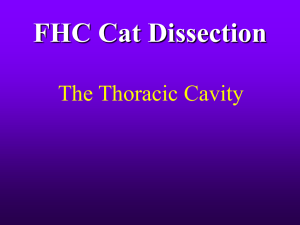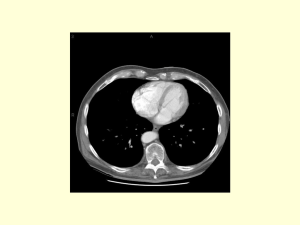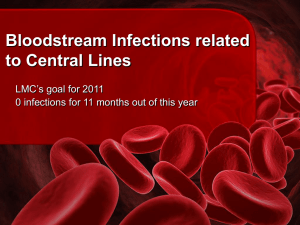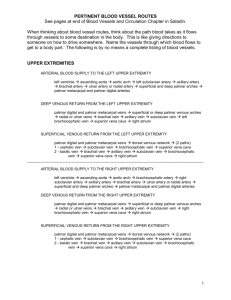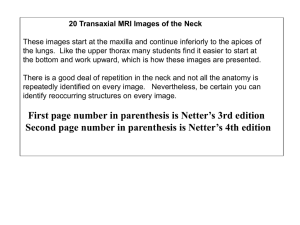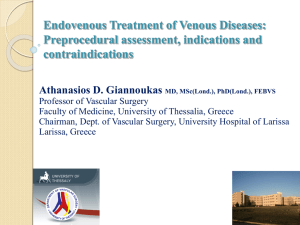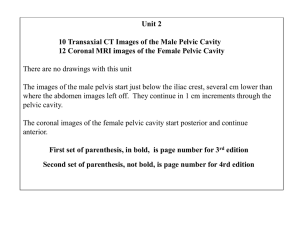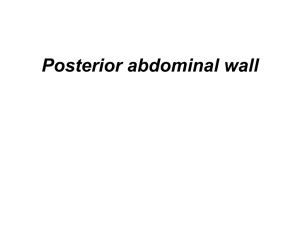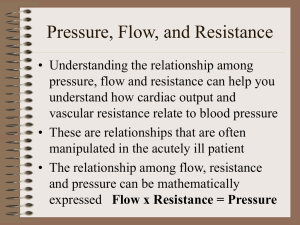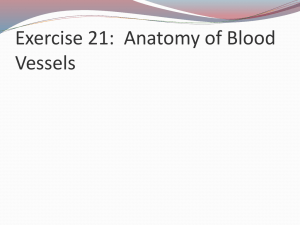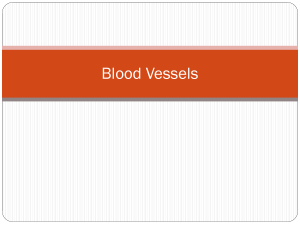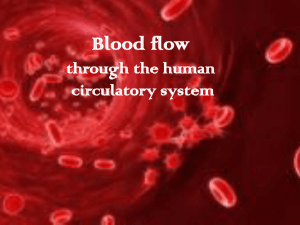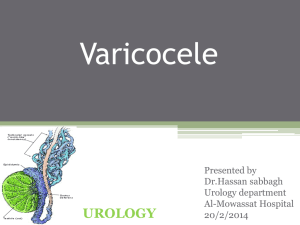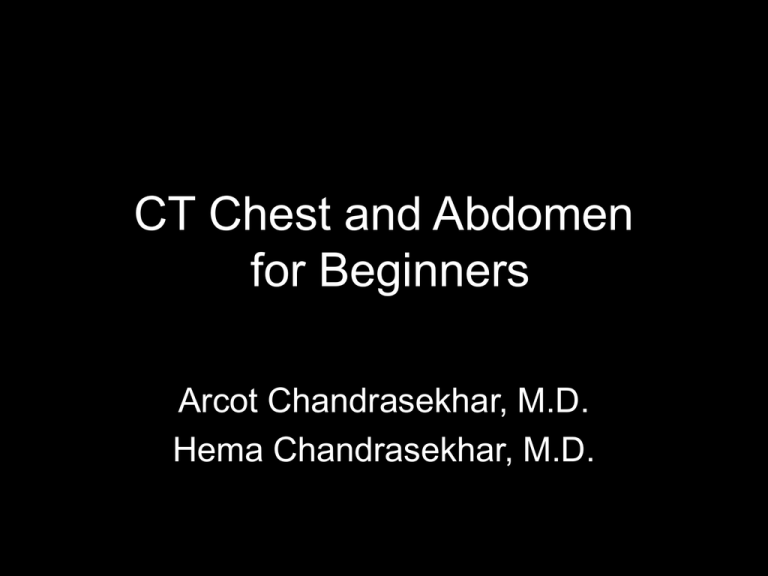
CT Chest and Abdomen
for Beginners
Arcot Chandrasekhar, M.D.
Hema Chandrasekhar, M.D.
Recommended way to use presentation:
• Use it as a slide show.
• Decide on one structure and follow the sequence,
example aorta.
• Next attempt to see its relationship to other structures.
• Study it multiple times until you are comfortable in
identifying each structure.
• When in doubt, follow the structure above and below and
it will become evident.
Exercises: First go through the entire
sequence.
1. Follow axillary vein to superior vena cava entering right atrium.
2. Follow iliac veins to inferior vena cava entering right atrium.
3. Follow splenic vein to portal vein.
4. Follow aorta originating from LV to bifurcation to common iliac arteries.
5. Follow esophagus to rectum.
6. Follow trachea to RUL bronchus.
7. Follow SVC to RA to RV to main pulmonary artery and branches.
Focus on one structure and use the pg up/pg down option to follow it.
At the level of
Contrast is injected in the right antecubital vein.
Follow the contrast in the next few slides.
Trachea
Contrast in
axillary vein
Thyroid cartilage
Humerus
Cervical spine
Clavicle
Scapula
Pectoralis major
AC joint
Supraspinatus
Thyroid Gland
Thyroid gland
First rib
First rib
Apex of lung
Rt common carotid artery
Rt subclavian artery
Medial end of clavicle
The subclavian vein joins the internal jugular vein to form the brachiocephalic
vein behind the medial end of clavicle.
Subclavian vein
Right
Left common carotid artery
Left subclavian artery
The brachiocephalic vein is also called the innominate vein.
Sternum
Because contrast was injected on the right side there is no visible contrast in
left brachiocephalic vein.
Left brachiocephalic vein
Innominate vein
Brachiocephalic artery
Left
A: Brachiocephalic artery
B: Left common carotid artery
C: Left subclavian artery
A
B
C
See how the left brachiocephalic vein is joining the right brachiocephalic vein to
become the superior vena cava.
Contrast in the right brachiocephalic vein has been diluted by blood from the left
brachiocephalic vein as they combine to form the SVC.
Arch
Aortic
ofarch
aorta
SVC
Mediastinal fat
Scapula
Ascending aorta
Main pulmonary artery
Descending aorta
Contrast in SVC is diluted by blood from the azygous vein.
Esophagus
Azygous vein
Left pulmonary artery
Carina
Right pulmonary artery
Main pulmonary artery
RUL bronchus
Left pulmonary artery
Left main bronchus
SVC
Intermediate bronchus
LUL division
Ascending aorta
Rt atrium
Rt ventricle
Pulmonary vein
Lt atrium
A: Aortic root
RV
RA
A
LV
LA
Aortic valve
Rt ventricle
Lt ventricle
Interventricular septum
Osteophyte
IVC
Liver
Heart
Stomach
GE junction
Esophagus
Stomach
Liver
Spleen
Lt lobe
Rt lobe
Fissure for ligamentum teres
Fissure for ligamentum venosum
Caudate lobe
Diaphragm
Caudate lobe
Diaphragm
Portal vein
Lt adrenal
Portal vein
Rt adrenal
Surgical clips in gallbladder fossa.
Coeliac trunk
Pancreas
Splenic vein
The splenic vein lies in the posterior pancreatic grove and joins the superior
mesenteric vein to form the portal vein.
Pancreas
Duodenal bulb
IVC
Rt renal artery
The right renal artery is retrocaval.
Small cyst in the left kidney.
Lt renal vein
IVC
Left renal vein emptying into the IVC.
Transverse colon
Ileum
Kidney
Kidney
Right
Descending colon
Right
Renal pelvis
Ascending colon
Right colon with fecal material.
Abdominal aorta about to bifurcate.
Psoas
Rt common iliac artery
IVC
Lt common iliac artery
L5
Arrows are pointing to the common iliac veins joining to form the IVC.
Left
Ilium
Sacrum
Arrows are pointing to the internal and external iliac veins joining to form the
common iliac vein.
Ilium
Sacrum
Rectosigmoid
Sacroiliac joint
Diverticula in recto sigmoid
Rectosigmoid
Arrows are pointing to air filled diverticulum and the second one is filled with
residual barium from an old GI study.
Gluteus
Bladder
Seminal vesicle
Rectum
Femoral artery
Femoral vein
Bladder
Prostate
Rectum
Femoral head
Acetabulum
Feces in the rectum
Pubic symphysis
Ischiorectal fossa
Shaft of penis
Femur


